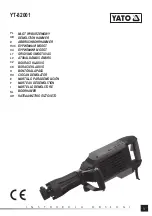
3 YEARS
LIMITED WARRANTY
Built to Exceed
8
(1) Clean the bit shank and apply grease before inserting the bit.
(2) Insert the bit into the tool. Turn the bit with slight pressure, you can feel a spot where there is a
hitch. At that spot, push it in until engages in.
(3) Pull the bit to make sure it is locked completely.
(4) To remove the bit, fully pull the flex sheath in the direction of the arrow and pull out the tool.
2. Auxiliary handle (Fig.2)
Operate your power tool only with the auxiliary handle .
The auxiliary handle can be set to any position for a secure and low-fatigue working posture.
Turn the bottom part of the auxiliary handle in counterclockwise direction and swivel the auxiliary
handle to the desired position. Then retighten the bottom part of the auxiliary handle by turning
in clockwise direction.
Pay attention that the band of the auxiliary handle is positioned on the front housing as intended
for.
3. Install the Orientation Staff Guage (Fig.2)
(1) Loosen the papilionaceous bolt on the auxiliary handle, and insert the staff gauge into the
mounting hole on the side handle.
(2) Adjust the staff gauge position according to the depth of the hole and tighten the papiliona-
ceous bolt securely.
4. Regulating the number of rotations and hammering (Fig. 3)
This Rotary Hammer is equipped with a built-in electronic control circuit that can adjust and regula-
te the number of rotations and times of hammering. This Rotary Hammer can be used by adjusting
the speed adjuster knob, depending upon the contents of operation, such as boring holes into
fragile materials, chipping, centering, etc.
The scale’1’ of the speed adjuster knob is designed for a minimum speed with the number of 235
rotations per minute and 1350 times of blow per minute. The scale ‘6’ is designed for a maximum
speed with the number of 514 rotations per minute and 2950 times of blow per minute.
CAUTION:
Do not adjust the speed adjuster knob during operation. Doing so can result in injury because the
Rotary Hammer must be held by only one hand, disabling the steady control of the Rotary Hammer.
5. Indicator LEDS (Fig. 4)
The green power-ON indicator LED lights up when the tool is plugged. If indicator led does not light
up, the mains cord or the controller may be detective. The red service indicator LED lights up when
the carbon brushes are worn out to indicate that the tool needs servicing.
Summary of Contents for SCHOCK DAMON SD4210
Page 3: ...3 YEARS LIMITED WARRANTY Built to Exceed 1...
Page 17: ...3 YEARS LIMITED WARRANTY Built to Exceed 1...
Page 29: ...3 YEARS LIMITED WARRANTY Built to Exceed...
Page 30: ......




































